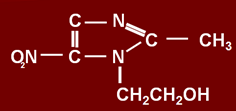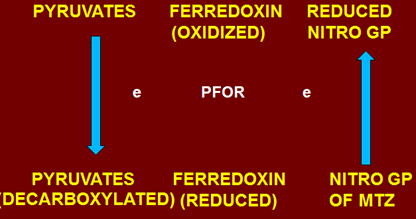Metronidazole is a prodrug itself, activated by reduction of nitro group.
Structure
Mechanism Of Action
Protozoa get energy by ketoacids e.g. pyruvates. This mechanism is described as:
The active form:
- affects DNA structure
- react with other proteins and molecules in protozoa and some anaerobic bacteria.
In DNA:
- loss of helical structure
- strand breakage may occur
- intercalation when molecules fits between base pairs.
Mechanism of resistance
1. These protozoa are anaerobic, thus have mechanisms for scavenging oxygen or ROS. If mechanisms which scavenge oxygen are effected, decreased clearance of ROS occur leading to excess and decreased reduction of nitro group of metronidazole due to competitive inhibition with reduction reaction.
2. In ETC,
i. PFOR
ii. Ferridoxin are important
Now in some there is decreased PFOR and ferridoxin probably due to chromosomal mutations, leading to decreased action of drug.
This can occur by:
- Increasing the dose
- Prolonging therapy
This resistance is seen in:
- Giardiasis
- Trichomonas infection
- Microaerophilic bacteria i.e.
- H. pylori
- Campylobacter species
Resistance is not seen in E. histolytica.
Spectrum of activity
A) Anaerobic protozoa
- E. histolytica
- T. viginalis
- B. coli
- Giardia lamblia and G. intestinalis
B) Anaerobic bacteria
Both gram positive and negative.
- Bacteroides species esp. B. fragilis
- Clostridial spp
- Peptococcus
- Peptostreptococcus in oral cavity, so used by dentisits
- Fusobacterium
- eubacterium
C) Microaerophilic bacteria
- H. pylori
- Campylobacter spp
D) Adult dracunculis medinensis (Guinae worm)–
- Especially metronidazole aids extraction of worm
- Does not kill the worm
Therapeutic Uses
| Spectrum | Therapeutic uses |
| E. Histolytica |
Oral tablets I/V infusion in severe cases 3 times per day 7-10 day course -400 mg tablets thrice daily |
| T. Vaginalis | Vaginal & urethral Trichornoniasis
Treat both male and femal patients 2g/day in OD dose |
| Giardia lamblia | Giardiasis
250 mg thrice daily for 7-10 days. |
| Ballantidium coli | Ballantidiasis |
| Anaerobes
Bacteroides fragilis Helicobacter pylori |
Pelvic and other below the diaphragm anaerobic infections(appendicitis, combined with penicillin or aminoglycosides)
Triple regime is used.
Also used in NSAIDS induced ulcers. Used in combination with:
|
| Gardenella vaginalis |
|
| Peptococcus
Peptostreptococcus Fusobacterium |
Used with penicillins |
Other Uses
- Crohn’s disease
- Guinea worm infestation (extraction)
- Pseudomembranous enterocolitis due to prolonged use of ampicillin or clindamycin, etc. Metronidazole is drug of choice. Vancomycin can be used (its only oral indication).
Pharmacokinetics
- Oral, I/V, vaginal creams or even topical preparations
- Very well absorbed, very little reaches colon, so usually combined with luminal anti-amoebics e.g. Diloxinide etc.
- Distribution is equal to total body water
- PPB is <20%
- Distributed to saliva, milk and CSF, pleural cavity, vaginal secretions, urethra and even in bones.
- Metabolism occurs in liver by oxidation and glucuronidation. It can be increased by phenobarbitone, phenytoin sodium and rifampicin. It can be inhibited by cimetidine.
- Excretion of metabolites occurs through kidneys.
Side-effects
Toxic and Irritative actions
- nausea
- headache
- dry mouth
- metallic taste (as secreted in saliva like clarithromycin, very unpleasant taste)
- dark coloured urine (reddish brown in color due to excretion of pigments like furazolidine and rifampicin)
One needs to educate patients about these effects.
CNS
- diziness,
- vertigo,
- insomnia,
- parasthesias
Others
- leukopenia,
- phlebitis (i/v),
- mutagenic in bacteria and carcinogenic in rodents –not seen in humans AIMS test is done to check it.
Teratogenic
- not significant effect
- avoided in 1st trimester
Allergic reactions
- Pruritis,
- Urticaria,
- Flushing,
- Stevens johnson’s syndrome (erythema, multiformis major oral mucosa and conjunctiva)
In severe cases –myocarditis, pleuritis, may be fatal.
Super-infections
- Oral candidiasis
- Stomatitis
Disulfiram like reactions
When combined with alcohol. Symptoms include:
- nausea
- vomiting
- abdominal pain
- dizziness
- vertigo
- even seizures
Used in alcohol aversion therapy. Other drugs causing it include:
- Cephalosporins (having MTT ring)
- Sulfonyl ureas
 howMed Know Yourself
howMed Know Yourself






